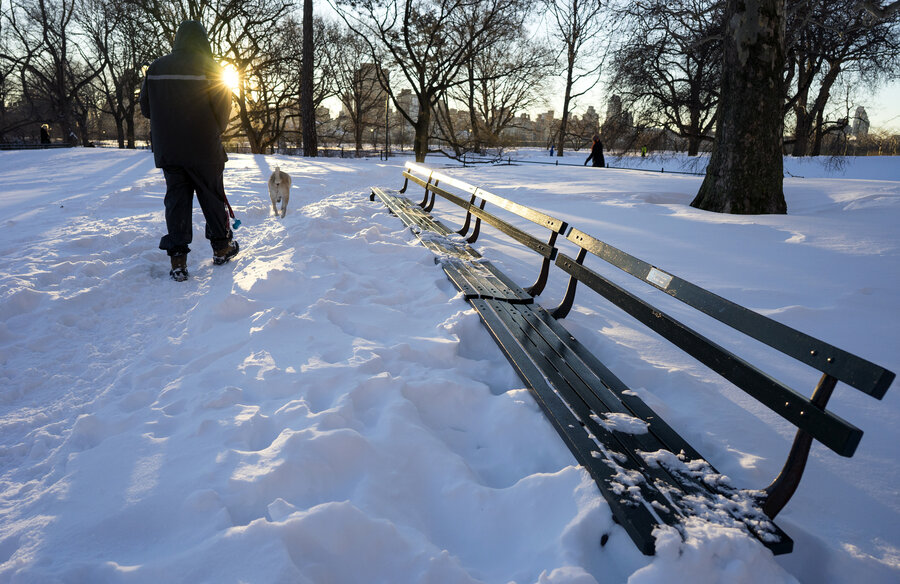Snowy East Coast digs out after mammoth blizzard
Loading...
| NEW YORK (AP)
Millions of Americans started digging themselves out Sunday after a mammoth blizzard with hurricane-force winds and record-setting snowfall brought much of the East Coast to an icy standstill.
New York and Baltimore began lifting travel restrictions and hearty souls ventured out on snow-choked streets, while mass transit systems up and down the coast gradually restored normal service.
But even as United Airlines said limited service might begin later in the afternoon in New York City, airports in the Washington D.C. area were likely to remain closed Sunday, and other airlines started to cut Monday service in addition to the 7,000 already-canceled weekend flights.
The massive snowstorm brought both the nation's capital and its largest city to a stop, dumping as much as 3 feet of snow and stranding tens of thousands of travelers. At least 18 deaths were blamed on the weather, resulting from car crashes, shoveling snow and hypothermia.
The storm dropped 26.8 inches in Central Park, the second-most recorded since 1869 and just short of 26.9 inches set in February 2006. The 26.6 inches that fell on Saturday, however, was the city's record for a single day.
The storm dropped snow from the Gulf Coast to New England, with areas of Washington surpassing 30 inches. The heaviest unofficial report was in a rural area of West Virginia, not far from Harpers Ferry, with 40 inches.
"This is kind of a Top 10 snowstorm," said weather service winter storm expert Paul Kocin, who co-wrote a two-volume textbook on blizzards.
The usually bustling New York City looked more like a ghost town. With Broadway shows dark, thin crowds shuffled through a different kind of Great White Way, the nickname for a section of the theater district. And Bruce Springsteen canceled Sunday's scheduled show at Madison Square Garden.
In Washington, monuments that would typically be busy with tourists stood vacant. All mass transit in the capital was to be shut down through Sunday.
In northern Virginia, streets began to show signs of life Sunday morning, though plow trucks outnumbered passenger vehicles. Chris Courtney, an investment adviser from Fairfax Station, called ahead to confirm he could complete his usual Sunday routine: a coffee and a newspaper.
"I wanted to give them business," said Mr. Courtney, 61. "I've got to believe they worked all night, the plow drivers."
Travel conditions were improving from the dangerously snowy, icy roads that led to crashes that killed several people Friday and Saturday. Those killed included a 4-year-old boy in North Carolina; a Kentucky transportation worker who was plowing highways; and a woman whose car plunged down a 300-foot embankment in Tennessee. Three people died while shoveling snow in Queens and Staten Island.
An Ohio teenager sledding behind an all-terrain vehicle was hit by a truck and killed, and two people died of hypothermia in southwest Virginia. In North Carolina, a man whose car had veered off an icy-covered road was arrested on charges of killing a motorist who stopped to help.
In Kentucky, Pennsylvania and West Virginia, drivers were marooned for hours in snow-choked highways.
Roofs collapsed on a historic theater in Virginia and a horse barn in Maryland, while seaside towns in New Jersey, Delaware and Maryland grappled with flooding.
The snow was whipped into a maelstrom by winds that reached 75 mph at Dewey Beach, Delaware, and Langley Air Force Base, Virginia, the weather service said. From Virginia to New York, sustained winds topped 30 mph and gusted to around 50 mph. And if that weren't enough, the storm also had bursts of thunder and lightning.
Stranded travelers included Defense Secretary Ash Carter, whose high-tech aircraft, the Doomsday Plane, couldn't land at Andrews Air Force Base in Maryland after returning from Europe. Sec. Carter was rerouted to Tampa, Florida.







